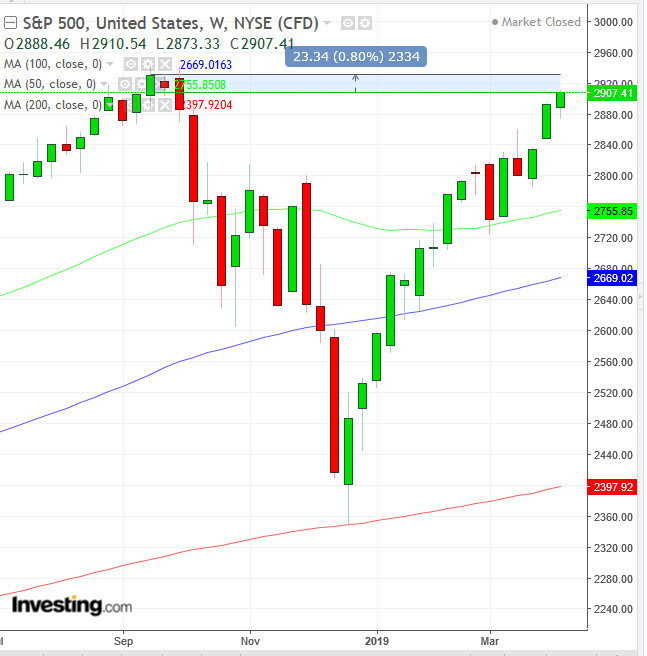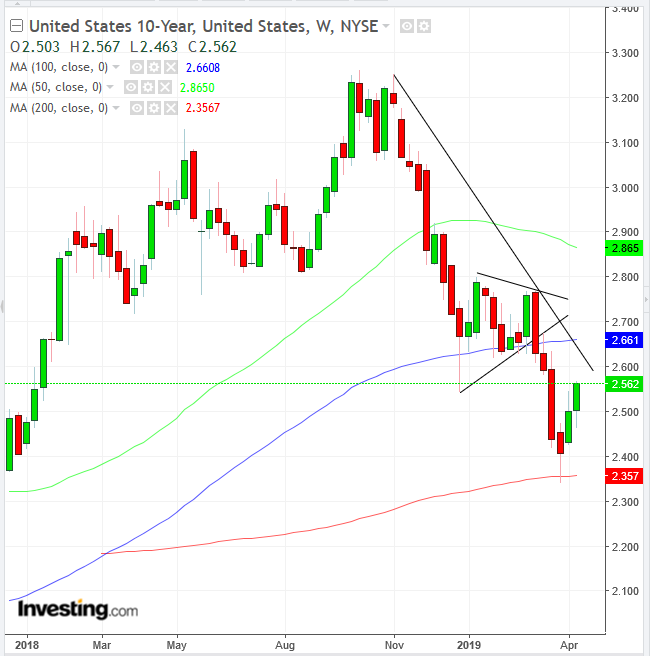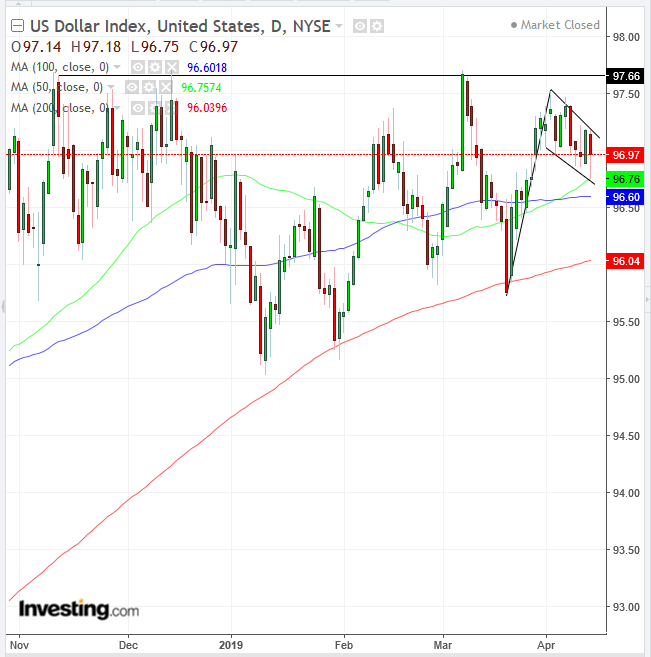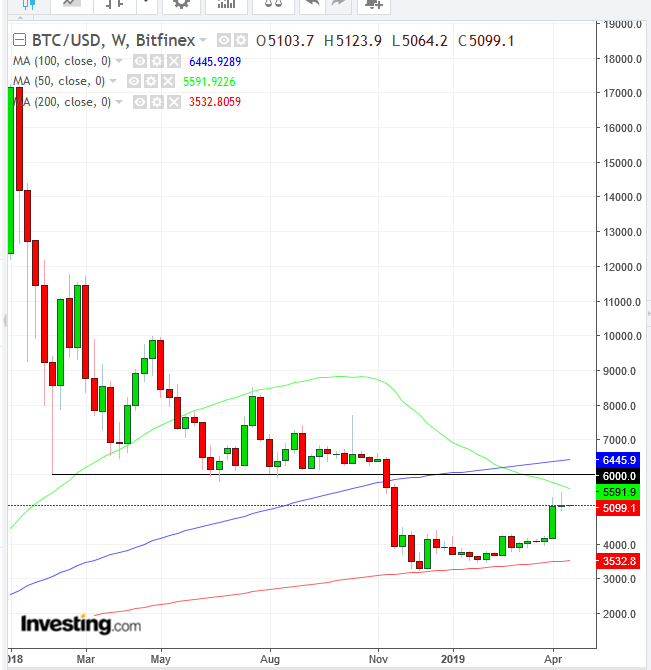- G-20 leaders see growth rising in second half of year, after IMF cut growth forecasts on trade tariffs
- Dovish central banks could keep equities pushing higher
- Dollar, Treasurys, gold drop
Though the International Monetary Fund (IMF) announced midweek it had cut its 2019 global growth outlook to 3.3% from 3.5%, G-20 financial leaders on Friday stated they see growth increasing during the second half of the year, the result of monetary accommodation. Nonetheless, the IMF forecast called for the slowest pace of expansion since the 2008 financial crisis, a result of ongoing U.S.-driven trade wars. Still, most U.S. stocks ended higher to finish the week, but were mixed on a weekly basis.
The U.K.'s Brexit deadline was postponed to Oct. 31 and Chinese exports and bank-lending showed a rebound in economic activity from the world's second largest economy. All told, the week ended on a positive note, triggered by hopes that the upside surprise in bank earnings—from Friday's Q1 2019 reports released by JPMorgan Chase (NYSE:JPM) and Wells Fargo (NYSE:WFC)—will extend to the broader earnings season results.
Confusing Mix of Divergent Signals
This confusing mix of outlooks, negative because of higher tariffs, but positive because of dovish central banks, left stocks flat, as investors attempt to wade their way through this elaborate labyrinth of divergent signals. To be honest, we too find it difficult to untangle the fundamentals. The technicals have been getting snarled as well.
The S&P 500 jumped on Friday, gaining 0.66%. Perhaps more significantly though, it pushed through the 2,900 psychological level for the first time in six months—saving gains for the week, with only Healthcare in the red (-0.92%), as the sector continued to lose ground as Republicans and Democrats continue sparring over the future of Obamacare and any possible Republican-backed replacement.
But it’s not just politics that are buffeting pharmaceuticals. So are free-market forces.
Amazon (NASDAQ:AMZN) has targeted health care as its next big disruptive play, claiming it will simplify a highly complex arena, by using its own online marketplace to slash drug prices. Since U.S. President Donald Trump has been keen to lower drug prices, would he be able to overcome his animosity toward the e-tail giant's CEO Jeff Bezos, in order to get this piece of his agenda done? We don’t know but the answer to that but it could be interesting to watch how things play out.
Financials led all ten remaining sectors higher, (+1.84%), after JPMorgan and Wells Fargo beat. Since both financial institutions reported before Friday's open, the sector boosted prices across the broader market which opened higher, producing an upside gap, closing a mere 0.8% from the Sep. 20 close.
Separately, entertainment giant Disney (NYSE:DIS) posted a fresh record, after it announced its new, Disney+ streaming service which will go live in November. The stock jumped 11.54% after the news broke. Conversely, shares of its competitor, Netflix (NASDAQ:NFLX) sank more than 4% to close out the week.
The SPX climbed for a third week, but just by a mere 0.51%, less than Friday’s gains. Healthcare was once again the laggard, -2.38%. Energy (-0.07%) slipped, as oil prices closed well off their daily highs and Chevron (NYSE:CVX) slumped after agreeing to buy Anadarko Petroleum (NYSE:APC).
Financials (+2.03%) were the week's best performers.

While a third consecutive weekly advance is promising on its face, the half-percent gain may be viewed as a sign the benchmark index is running out of steam. The previous week saw a 2.06% gain and the week before that the SPX rose 1.21% on a weekly basis.
This slowdown leaves investors with a conundrum—do they focus on the tepid weekly performance or on Friday’s jump, indicating investors were willing to commit to weekend positions, even after what may the anomalous opening to Q1 2019 earnings, with two upside surprises ahead of what is expected to be a rough season.
Another bearish signal was the mixed performance of the other U.S. benchmarks.

The Dow Jones Industrial Average may have outperformed on Friday (+1.03%), but the mega-cap index was flat for the week. It failed to overcome an evening star pattern (Apr. 4-8) (red circle.)
However, earlier, it completed a symmetrical triangle, whose upside breakout signaled another rally, reinforced with the pattern’s development over the 200 DMA, compounded by a golden cross, no less. Therefore, while we've been bearish in the short- to medium-term, we are forced to consider the evening star as a short-term bearish signal for a correction as part of a return move toward the symmetrical triangle, which may have been completed last week.
The next big test is the Oct. 3, 26,951.81 all-time high. If the price posts a new record with strength: volume, breadth (as of now, the ADL still provides a negative divergence) and a solid, closing basis, we would forego our bearish stance and become full-fledged bulls, irrespective of the known fundamentals.
The NASDAQ Composite climbed 0.46% Friday, posting a new high for the uptrend since the December bottom. However, it formed a doji, demonstrating a lack of will, even after the golden cross early in the month. The tech heavy-index climbed 0.57% for the week.
The Russell 2000 posted a 0.44% gain on Friday, forming a shooting star. For the week, the small cap benchmark eked out a 0.14% gain. Technically, while it closed above the 50 DMA, it remained below the Feb. 25 high.
Though we expect stocks to continue rising as they take on record highs, we're not prepared to change our medium-term bearish stance until we see record highs bested in a convincing manner. Fundamentally, we remain uncomfortable about relying on central banks to artificially boost markets.
The RBA seems baffled by similar contradictions, and former Fed Chair Alan Greenspan sees the future for equities as bleak. Though Greenspan did not provide timing for this expected slowdown he believes the economy will be burdened by rising entitlements proportionate to an aging population.

Yields jumped for a second week, to the highest level in almost a month, after the U.S. 10-year bounced off its 200 WMA when investors dumped Treasurys on both a dovish Fed and the return of risk-on sentiment. However, early March yields completed a bearish triangle, which means the current rally is considered corrective within a pullback toward the downtrend line since early November.
In other words, we would not be surprised if yields were to return to their downturn, or Treasurys to return to a rally, despite the outlook for lower rates that's currently part of the market narrative.

The dollar dropped Friday after the previous weekly close of 97.39, only 5 pips below the Dec. 10 peak for the uptrend since the January bottom.
The USD's fall was the price paid for it being the currency connected to Treasurys, as investors increased their risk profiles. Technically, however, the dollar is developing a falling flag, bullish in an uptrend, after bouncing for the fourth time off the 200 DMA, and before breaking through the 98.00 level, above the range since November.
Sterling advanced after Prime Minister Theresa May agreed to the EU proposal to postpone the Brexit deadline to October. Cable has resumed a potential bottom.

Strangely, gold fell in tandem with the dollar, ruining the risk-off market picture. Concurrent with the dollar’s bullish flag, gold is providing an expectation for a bearish environment, as it forms a potential top, complete with a close below $1,280.

IMF Managing Director and Chairwoman Christine Lagarde recently warned that cryptocurrencies are disruptive technologies that could render financial system unstable if not properly regulated. At the same time, the IMF launched its own, private blockchain-based crypto.
Technically, Bitcoin formed a weekly doji after the prior week’s surge, as its intraweek high reached the 50 WMA, after the MA fell below the 100 WMA, as it protects the $6,000 resistance of the prior support, ranging from February-November 2018.
The Week Ahead
All times listed are EDT
Monday
21:30: Australia – RBA Meeting Minutes: we don’t expect to see any breakthrough on the central bank’s outlook for a contradictory economy.
Tuesday
5:00: Germany – Zew Economic Sentiment: expected to jump to 0.9 from -3.6.
9:15: U.S. – Industrial Production: expected to jump to 0.2% from -0.1% MoM.
22:00: China – Industrial Production: seen to crawl higher to 5.6% from 5.3%. After a lingering trade dispute that still hasn't been resolved, it will be interesting to note the results of the world's two largest economies for this release, both announced today.
22:00: China – GDP: expected to edge lower to 6.3% YoY from 6.4% and down to 1.4% QoQ from 1.5%.
Wednesday
4:30: U.K. – CPI: forecast to edge higher to 2.0% from 1.9% YoY and to decline to 0.3% from 0.5% MoM.
5:00: Eurozone – CPI: expected to remain flat at 0.3% MoM, as well as 1.4% YoY.
8:30: Canada – Core CPI: probably rose to 1.8% YoY from 1.5%.
8:30: U.K. – BoE Governor Carney Speaks
10:30: U.S. – Crude Oil Inventories: expected to fall to 2.294M from 7.29M.
Thursday
3:30: Germany – Manufacturing PMI: likely to have edged higher to 45.2 from 44.1 MoM.
4:40: U.K. – Retail Sales: forecast to have plunged to -0.3% from 0.4% MoM.
8:30: U.S. – Core Retail Sales: expected to have surged to 0.7% from -0.4% MoM.
8:30: U.S. – Philadelphia Fed Manufacturing Index: expected to decline to 11.2 from 13.7.
8:30: U.S. – Retail Sales: forecast to jump to 0.9% from -0.2%.
8:30: Canada – Core Retail Sales: seen to edge higher to 0.2% from 0.1% MoM.
Friday
8:30: U.S. – Building Permits: expected to rise to 1.299 M from 1.291M.
